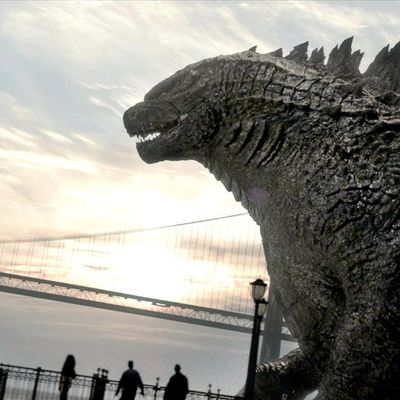
You expect a summer blockbuster to deliver some striking shots, and the new reboot of Godzilla has those in spades. But the most gobsmacking thing Godzilla throws at you isnÔÇÖt what you can see onscreen ÔÇö itÔÇÖs what you donÔÇÖt, thanks to the ballsiest cinematic cut of the year.
If you want to go into the movie fresh and spoiler-free, which I totally understand, stop reading here: IÔÇÖm going to discuss something that happens at GodzillaÔÇÖs midpoint, something thatÔÇÖs emblematic of the movie as a whole.
First of all, a little setup: As weÔÇÖve alluded to before, Godzilla doesnÔÇÖt show its titular beast until an hour into the movie, though you do spend that lead-up time meeting GodzillaÔÇÖs main foe, a giant, fearsome, spiderlike creature known as the M.U.T.O. (short for Massive Unidentified Terrestrial Organism). By introducing the M.U.T.O. early on, director Gareth Edwards is signaling to the audience that this wonÔÇÖt be a Godzilla-versus-the-city movie like Roland EmmerichÔÇÖs dire 1998 installment ÔÇö instead, his is a flick where Godzilla will battle other giant monsters, and he encourages you to anticipate the first big fight.
That comes in Hawaii, where the M.U.T.O. is wreaking havoc at a crowded airport late at night. The creature pulverizes anything it comes across there, moving unstoppably forward on its eight enormous legs as Edwards intercuts that carnage with scenes of Godzilla emerging from the Pacific. Finally, when the M.U.T.O. has turned just about everything at the airport into a fiery wreck, it skitters across the runway from left to right in one long shot, stopping only when GodzillaÔÇÖs giant foot ÔÇö this body part alone dwarfing the gigantic M.U.T.O. ÔÇö descends into frame in front of it.
And then we get our first hero shot of Godzilla. As the camera races up his scaly body, he roars ÔÇö and so does the audience, their bloodlust stoked. Godzilla was awakened from under the sea to stop this M.U.T.O., and that primal shriek means business. Oh, it is on!
And then the movie cuts away.
Suddenly, weÔÇÖre in San Francisco, where weÔÇÖve left Elizabeth OlsenÔÇÖs character and her young son. (OlsenÔÇÖs husband, a naval lieutenant played by Aaron Taylor-Johnson, is in Hawaii dealing with the M.U.T.O.). As Olsen natters on obliviously from the next room, her wide-eyed kid watches the special news report on TV, where we get our first brief glimpses of Godzilla absolutely thrashing that M.U.T.O. At first, the audience thinks that this must be an amusing sidebar ÔÇö that as soon as Edwards gets his laugh, heÔÇÖll cut back to the nighttime battle in Hawaii.
And then comes the even more audacious cut: Suddenly, itÔÇÖs the next day. Godzilla and the M.U.T.O. have already had their fight, and apparently it was a draw, because the giant lizard is halfway across the ocean right now, patiently pursuing the fleeing M.U.T.O. as it heads to San Francisco. (TheyÔÇÖll clash again, though not until much later.) The movie wound you up to expect a ten-minute-long fight scene between two big beasts, but instead of actually showing that, it asked you to use your imagination.
Needless to say, thatÔÇÖs not a request that most summer blockbusters make these days.
Some will find the cut kind of breathtaking; others will wonder if the projectionist forgot to put in a reel. At the press screening I went to, one frustrated fanboy behind me cried out, ÔÇ£Show the fight!ÔÇØ when Edwards repeated this gambit a bit later in the movie, once again delaying the expected battle royale until the third act. But if you can hang with it, the result of all that withholding is momentous: One of my major movie pet-peeves is when virtually unkillable CG creatures slug each other into submission for minutes on end (ahem, Man of Steel), and yet by the time Godzilla really, truly does face off with the M.U.T.O. in San Francisco, I was ready to leap out of my seat and cheer him on ÔÇö my pump was that primed. (I even murmured ÔÇ£wowÔÇØ twice during the final battle. I never do that!) Edwards calls his discreet approach ÔÇ£cinematic foreplay,ÔÇØ and itÔÇÖs a canny strategy that ensures that by the time the third act rolls around, youÔÇÖre not already too numbed by CG carnage to care.
So while there are twists and turns and visual turnabouts aplenty in this reboot of Godzilla, the most shocking thing in it remains that trippy ellipsis in Hawaii. You can feel a collective Wait, what? feeling from the audience when it happens, and Edwards is actively encouraging that. ThereÔÇÖs a difference, after all, between confusing you and disorienting you ÔÇö and the latter can be kind of fun, as long as the filmmaker gives you the time and tools to find your bearings afterwards. These days, you donÔÇÖt expect a summer movie to be several steps ahead of you, so when a film confidently skips forward and waits for you to catch up, itÔÇÖs almost like an announcement: The rules are broken, and anything is on the table.

